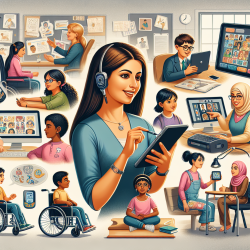Understanding the DYNC1H1 Gene: A New Frontier in Genetic Disorders
The world of genetics is ever-evolving, and the recent study on DYNC1H1-related disorders has opened new avenues for understanding and classifying genetic disorders. The clinical-phenotype continuum in DYNC1H1-related disorders has been explored in depth, providing insights into the genomic profiling and proposing a novel classification system. This blog delves into the implications of this research and how practitioners can enhance their skills by integrating these findings into their practice.
The Study: A Deep Dive into DYNC1H1
The research article titled "The clinical-phenotype continuum in DYNC1H1-related disorders—genomic profiling and proposal for a novel classification" investigates the mutations in the cytoplasmic dynein 1 heavy chain gene (DYNC1H1). These mutations are linked to rare neuromuscular (NMD) and neurodevelopmental (NDD) disorders, such as spinal muscular atrophy with lower extremity dominance (SMALED) and autosomal dominant mental retardation syndrome 13 (MRD13).
In a multi-center study, the phenotypes and genotypes of ten pediatric patients with pathogenic DYNC1H1 variants were analyzed. The study highlights the broad spectrum of clinical findings, suggesting overlapping disease manifestations with intermixed phenotypes ranging from neuropathy (peripheral nervous system, PNS) to severe intellectual disability (central nervous system, CNS).
Key Findings and Implications
The study identified nine novel mutations in the DYNC1H1 gene among the ten patients, each exhibiting a wide range of clinical manifestations. The genomic profiling emphasized the domain-specific effects of genetic variation in DYNC1H1, particularly the tolerance towards missense variants in the linker domain. The retrospective analysis revealed domain-specific genotype–phenotype correlations, which are crucial for practitioners to understand the disease's complexity.
One of the significant outcomes of the study is the proposal for a novel clinical classification for DYNC1H1-related disorders. This new classification encompasses a spectrum from DYNC1H1–NMD with an exclusive PNS phenotype to DYNC1H1–NDD with concomitant CNS involvement. This approach challenges the traditional classification into distinct disease entities, advocating for a more holistic understanding of the clinical manifestations.
How Practitioners Can Benefit
For practitioners, the insights from this study offer a roadmap to improve diagnostic accuracy and patient management. By understanding the domain-specific genotype–phenotype correlations, practitioners can tailor their diagnostic approach and treatment plans more effectively. Here are some practical steps practitioners can take:
- Stay Informed: Regularly review recent studies and publications related to genetic disorders to stay updated on the latest findings.
- Embrace Genomic Profiling: Utilize genomic profiling to understand the specific mutations and their implications for each patient.
- Adopt the New Classification: Implement the proposed novel classification in clinical practice to better address the spectrum of DYNC1H1-related disorders.
- Collaborate and Network: Engage with other professionals in the field to share insights and experiences, enhancing collective knowledge and patient care.
Encouraging Further Research
While the study provides a comprehensive overview of DYNC1H1-related disorders, it also highlights the need for further research. Practitioners are encouraged to contribute to ongoing research efforts, whether through clinical trials, case studies, or collaborative projects. By doing so, they can help refine the understanding of these complex disorders and improve outcomes for patients.
To read the original research paper, please follow this link: The clinical-phenotype continuum in DYNC1H1-related disorders—genomic profiling and proposal for a novel classification.










